IPVanish VPN
US-based IPVanish is an appealing VPN provider with a long list of features, including several that you won't often see elsewhere.
IPVanish has a decent-sized network with 40,000+ shared IPs, and 2,000+ servers (100 more have been added since our last review) in 75+ locations.
Some VPNs give you more, but as the company's website explains, IPVanish is 'the world's only Top Tier VPN service provider'. The firm owns and manages its servers rather than renting other people's hardware, giving it far more control over how the network and servers are set up and run.
IPVanish says all servers are P2P-friendly, and sure enough, we were able to download torrents from all five of our test locations.
- Want to try IPVanish? Check out the website here
A wide range of apps covers Windows, Mac, Android, iOS, even Amazon Fire TV, and IPVanish further provides a host of setup guides for routers, Linux, Chromebooks and other platforms.
Feel free to install, configure and set up as many devices as you like – IPVanish has no fixed limits on the number of simultaneous connections you can make. We guess the company might get in touch if you reach 20 and are still going, but that's still a major improvement on the typical 5 device limit you'll get with many providers.
Wide protocol support starts with the turbocharged WireGuard offering. Though if you prefer something else, don't worry, IPVanish likes choice, too: there's support for OpenVPN, IKEv2, L2TP, SSTP, and PPTP.
We're less convinced by the older protocols here; PPTP is so insecure that most providers dropped it long ago. But if you know what you're doing, and you only ever use it in situations where security is unimportant (unblocking a website, say), it may be useful to have an extra option.
24/7 live chat support is available if you need it, but even here, IPVanish delivers a little more than we expected. There's 7-day a week phone support (9am – 5pm CT, that's UTC -6), with numbers in the US, UK, Australia, Mexico, Spain and Brazil (note that Germany has been dropped from the list since our last review).
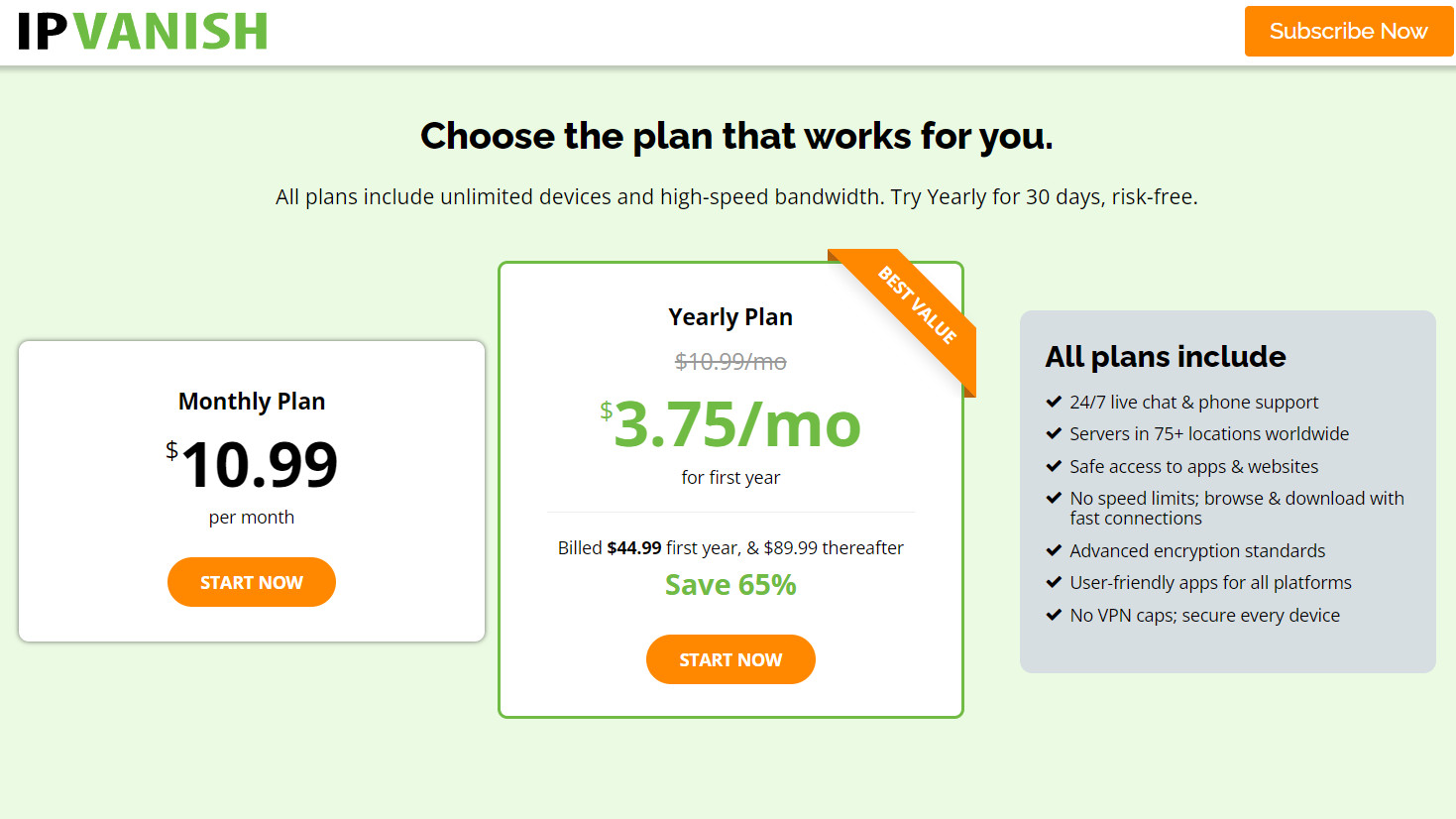
IPVanish pricing
IPVanish pricing for its VPN service starts with monthly billing at $10.99.
A new quarterly plan is only $5 a month for the first term, though it doubles to an expensive-looking $10 on renewal.
The annual plan looks good value at $3.75 a month, especially as it also includes VIPRE Antivirus Security. But beware, as with the quarterly plan, this is a special introductory deal. Prices jump to $7.50 on renewal.
IPVanish's VPN + Backup plan is no longer available, and the company doesn't offer SugarSync with any of the latest plans.
If you're only looking for the VPN, opting for another provider could cut your costs significantly. Private Internet Access has a 3-year plan that costs just $2.03 for the first 39 months (there's 3 months free), an upfront payment of $79. IPVanish asks $44.99 for year one, $89.99 for years two and three; a total of $225.
IPVanish looks like a better deal if you'll use the bundled VIPRE Advanced Security. It's a capable security suite which includes antivirus, ransomware protection and a firewall for up to 10 devices. Beware, though: it only protects Windows and Mac devices. You'll get better protection, and iOS plus Android support, from providers such as Norton or Bitdefender.

If you decide to sign up, IPVanish accepts payments via card and PayPal, but there's no Bitcoin support.
IPVanish offers a 30-day money-back guarantee, but be sure to check the small print: it's for yearly plans only. Monthly-billed plans aren't eligible.

Privacy
Most IPVanish apps come with a range of privacy-protecting tools. The Windows build includes a kill switch, DNS and even IPv6 leak protection to reduce the chance that your traffic or identity might be exposed online.
Privacy pluses elsewhere include the iOS app's ability to automatically connect when you access public Wi-Fi networks, but ignore others which you feel are safe (home, work, whatever they might be). You can then mostly leave the VPN to turn itself on and off as required, maintaining your privacy at all times.

To confirm that the service really does preserve your anonymity, we used IPLeak, DNS leak test and a number of other leak-detecting sites. None of the tests revealed any issues, with the apps always shielding our identity and traffic.

Logging
IPVanish's privacy policy begins with a clear and reassuring statement: 'IPVanish is a zero-logs VPN service provider, which means that we do not keep a record of any connection, traffic, or activity data in regards to our Services.'
The document lists the data IPVanish collects via the website, its registration and payment procedures. There's nothing harmful or out of the ordinary, and we only saw the details we expected: cookies, website analytics, email address and so on.
IPVanish doesn't just have reassuring words, either. In April 2022 it backed them up with a blog post announcing that Leviathan Security Group had 'audited our technology and independently verified that our no-log VPN service complies with our Privacy Policy. '
The audit was unusually detailed, and included interviews with staff, a range of technical tests, and examination of a production server, documentation, system configurations and more. (The full report is linked from IPVanish blog post, if you're interested.)
It's great to see a provider with the courage to put itself through this level of scrutiny, and we hope it'll encourage other providers to do the same.

Performance
We measure VPN performance by running several benchmarking services – SpeedTest's website and command line app, SpeedOf.me, nPerf – from both a UK data center and a US residential location (both have 1Gbps connections). We run each benchmark five times with OpenVPN, five times using WireGuard, and we do it all over again several hours later (that's a minimum of 120 tests), then analyze the data to see what's going on.
UK OpenVPN speeds were disappointing at 120-160Mbps. The US results were a more reasonable 300Mbps, but that's still only mid-range, and far behind OpenVPN leaders like Hide.me (550-580bps) and Mullvad (700-710Mbps).
IPVanish turned it all around when we switched to WireGuard, though, with download speeds peaking at 700Mbps from our UK location, 890Mbps in the US. That places IPVanish in an impressive third place out of our last 25 speed tests – only Hide.me (900Mbps) and TorGuard (950Mbps) scored higher.
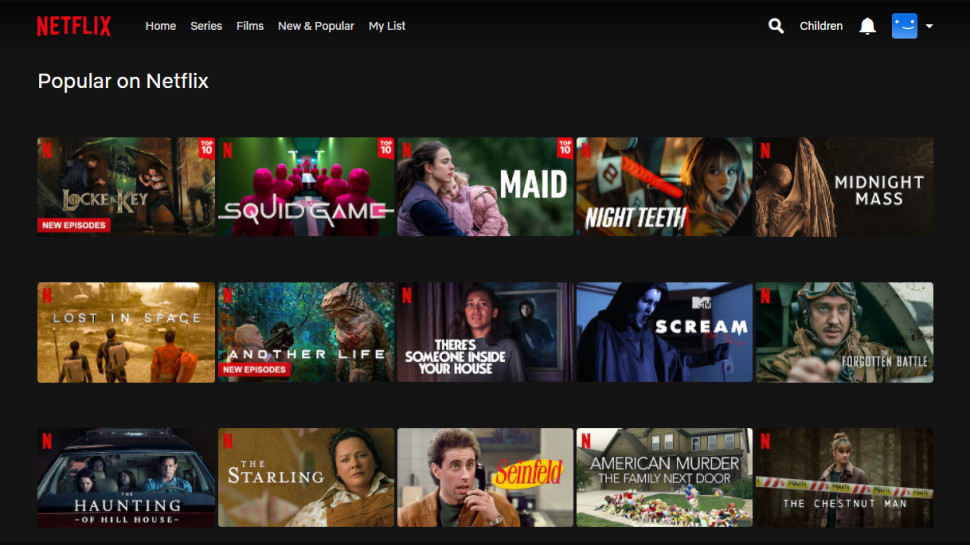
Netflix and streaming
IPVanish claims to offer "secure access to all of your favorite streaming sites … uninterrupted from video buffering and lag times." That's not always been our experience in previous reviews, but we were keen to see how the service performed this time round.
It got off to a great start, bypassing BBC iPlayer's VPN defenses and allowing us to stream whatever we liked.
IPVanish also unblocked Disney Plus without any difficulty. That's good news, as we weren't able to access the platform in our last review.
US Netflix is often the most difficult challenge, so we were happy to see IPVanish unblock US content. The service wasn't effective with Netflix in other countries, though. If that could be a problem for you, be sure to test unblocking carefully if you sign up.
There was more bad news in our final test, when Amazon Prime Video detected the VPN and refused to stream anything.
Three out of four is a decent result, but some providers do better. CyberGhost, ExpressVPN, Hotspot Shield, NordVPN, ProtonVPN and Surfshark (plus others) all scored 100% in our most recent unblocking tests.

Windows app
IPVanish does its best to help you get started, whatever your platform. There are apps available for Windows, Mac, Android, iOS and Fire TV. There are no browser extensions, but the support pages have setup guides for Chrome and Firefox, as well as tutorials covering routers, Chromebooks, Linux and more.
We grabbed the Windows app, and within a few seconds it was installed and ready to go.
The app's opening Quick Connect panel looks cluttered, but that's mostly because it has so much functionality.
Tap Connect and a status panel displays the protocol being used, time connected, server name, and data uploaded and downloaded, a level of detail you'll rarely see elsewhere. The client even displays a good-looking real-time graph of your upload and download speeds. (Essential? Probably not, but you have to applaud the developer's efforts.)

If you don't like this interface, one click is all it takes and you're viewing a more conventional country list. This looks more like other apps, but again, IPVanish has added extra features. A search box enables filtering the list by keyword. You can sort the list by country, load or response time. You're able to add servers to a Favorites list with a click, and these can be sensibly displayed at the top of the country list, rather than hiding them away on a separate tab.

Map
The app has a truly excellent map interface – probably the best we've seen from any VPN provider.
The map isn't some fixed graphic, for instance – it's dynamic, and works exactly as you'd expect. You can click and drag to move around, and clicking the zoom buttons or spinning the mouse wheel zooms you in and out, and changes the detail level.
The map also includes genuinely useful information. The default zoomed-out view displays a marker showing 155 servers in the approximate area of California, for instance – double-click this and you'll be connected to your nearest location. If you're in the area, though, zoom right in and you'll see servers in Los Angeles, San Jose, Phoenix and Las Vegas, and you can double-click on any of these to get connected.
Oh, and if you're tired of Windows VPN apps with cramped fixed-size map interfaces, no problem – IPVanish's can be freely resized, or even maximized, allowing you to take full advantage of your display. (That's not just a benefit for the map, though – it gives you more space in the other panels, too.)
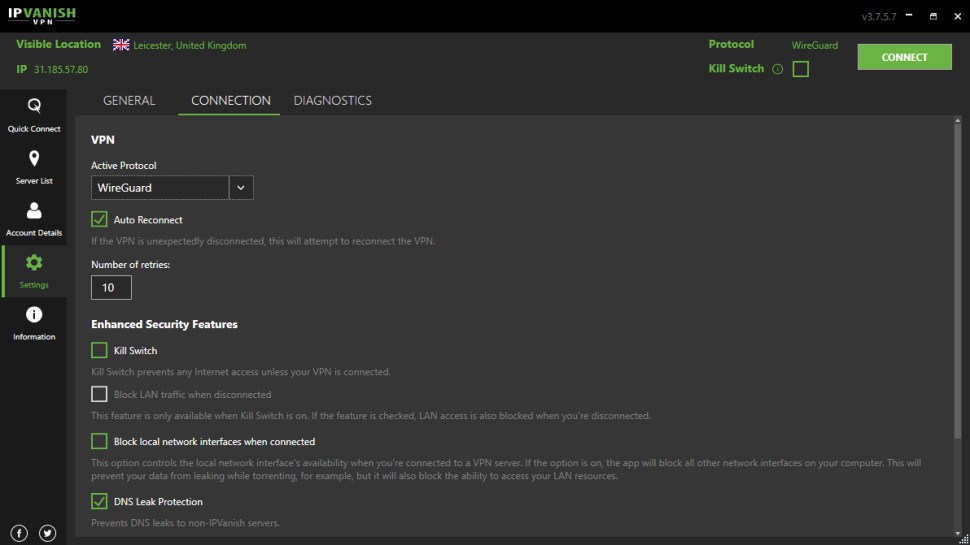
Settings
The Settings box has a decent bunch of options. You can switch protocols between WireGuard, IKEv2, SSTP, PPTP and L2TP, as well as OpenVPN TCP and UDP. You're able to choose an OpenVPN port (1194 or 443). There's both DNS and IPv6 leak protection. You can define which server IPVanish uses when the client starts, repair the IPVanish OpenVPN driver if it's affected by another VPN, and view the OpenVPN logs within the interface to troubleshoot problems.
The client's kill switch isn't enabled by default, so we turned it on and ran a few tests. The results were excellent in every area: whatever tricks we pulled to break the connection, whatever protocol we used, the client warned us immediately with a desktop notification and reconnected if we'd enabled that option in Settings, without ever revealing our real IP.
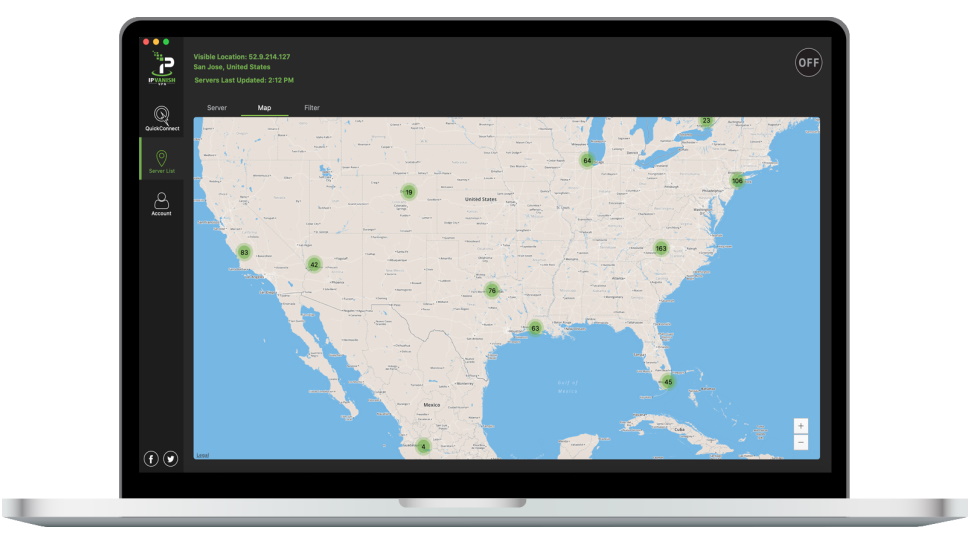
Mac app
The IPVanish Mac app is a better-looking but marginally less powerful version of the Windows client.
There's more visual style here. The Windows app has an ugly dark theme, with a spiky data transfer chart which jumps every second as it updates. The Mac app has both dark and more appealing light themes, with a colorful map, and nicely shaded curves on its smooth-scrolling transfer graph.
The app doesn't have all the low-level tweaks available on Windows. There's no option to set the number of retries if it can't connect, for instance, and you can't decide whether (or not) to block local network interfaces when the VPN is active.
All the most important features are included, though. There's a kill switch (recently rewritten to 'increase stability and speed'), and very wide protocol support (WireGuard, OpenVPN, IKEv2, IPSec, L2TP). There's even a Mac bonus feature in the ability to automatically connect (or disconnect) when you access untrusted Wi-Fi and Ethernet networks.
The app may not be right for everyone. The interface looks better than on Windows, for instance, but it's still more cluttered than most of the competition. But overall, it's a decent mix of power and ease of use, and well worth a try.
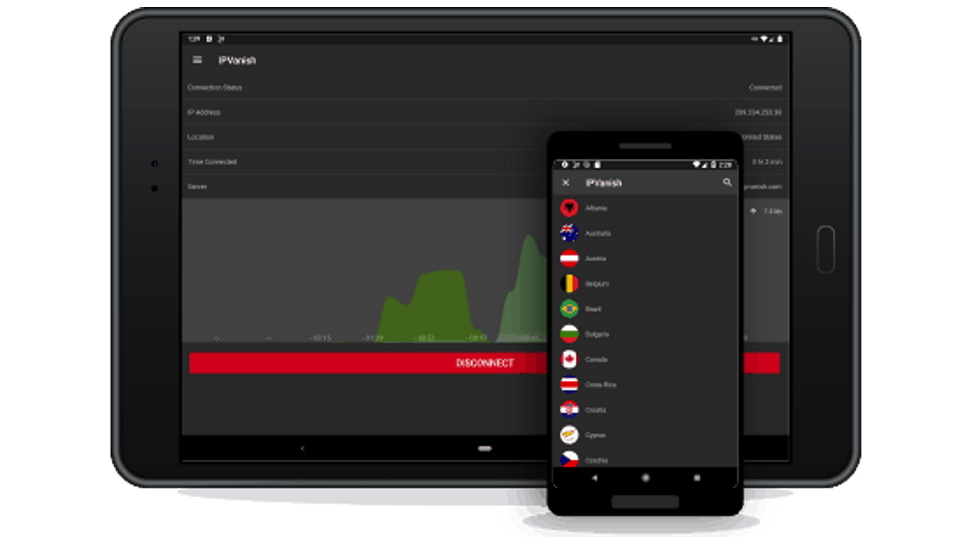
Android app
The IPVanish Android app opens with the current location highlighted on a map, and provides a Connect button to speedily get you online.
The mobile apps don't allow you to choose your locations from the map, and instead present you with a straightforward location list. By default, this shows countries, but you can switch to cities with a tap. There are no visible latency figures to help you choose, unlike the desktop – but you are now able to save your most commonly-used locations as Favorites, a welcome new addition since our last review.
The scrolling data charts have been dropped, but the app still has some useful status information: your new IP address, server name, location, time connected, and so on. It's welcome reassurance that the system is working as you would expect.
The app has more settings and options than most of the competition. There's support for WireGuard, IKEv2 or OpenVPN connections, for instance. You can opt for OpenVPN UDP or TCP connections, optimizing for speed or reliability. There's a wider choice of ports than you'll see with the Windows client (443, 1194 and 8443).
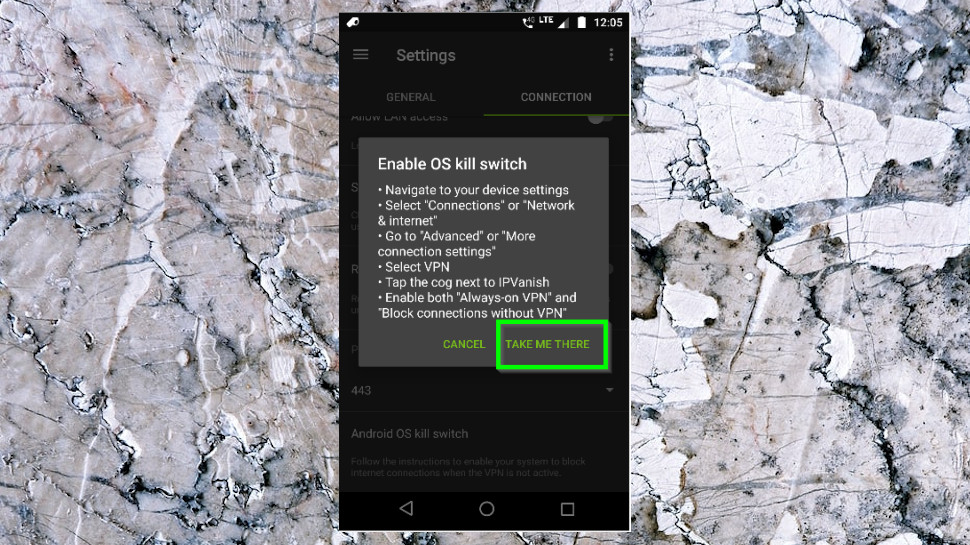
A Scramble feature makes it more difficult for networks to detect and block VPN connections. A Split Tunneling feature allows you to select apps you don't want to use IPVanish; great news if some of your apps don't work with VPNs. And although the app doesn't have a kill switch of its own, there is help in setting up the system-level kill switch on Android.
There are some omissions. While the IPVanish Mac app (and apps from many other providers) can automatically connect whenever you access an insecure Wi-Fi network, IPVanish doesn't offer that ability on Android. The app more than covers the basics, though, and overall, it works reasonably well.
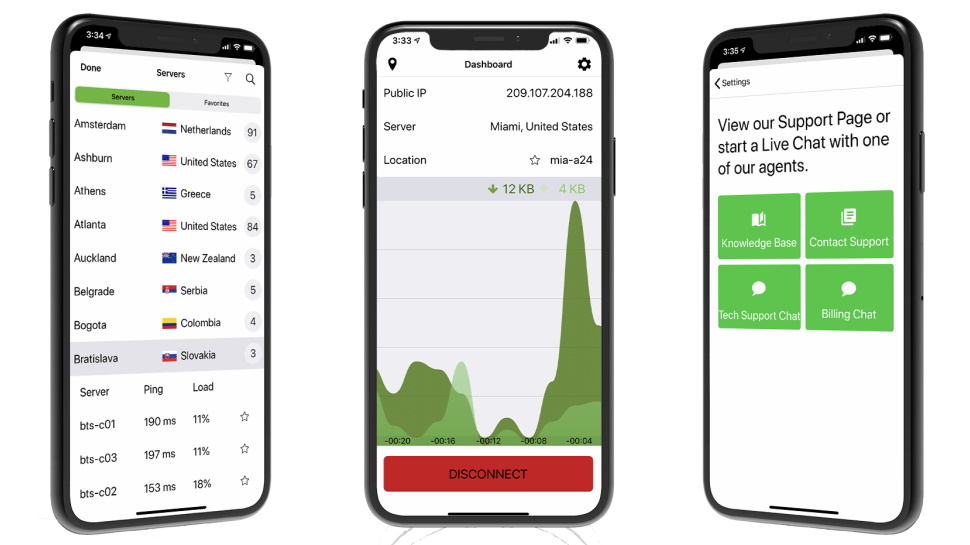
iOS app
The IPVanish iOS app beats the rest of the range for visual appeal in our opinion. Its light theme stands out, the colorful traffic graph scrolls smoothly, and the smart layout minimizes clutter to give it a cleaner feel.
You're able to choose locations from lists of cities, countries or individual servers. Once you've found what you need, it's easy to save it as a Favorite for easier recall later.
The Settings pane looks sparse, at least at first glance. There's no integrated kill switch to protect your identity, and you only get two significant VPN tweaks: an auto-connect option, and the ability to switch protocol between WireGuard, IKEv2 and IPSEC.
Check out that auto-connect feature, though, and you'll find a stack of options and controls (essentially, everything we'd like to have seen on the Android app). As well as a basic 'connect automatically' setting, you can have IPVanish turn itself off when you're connected to trusted cellular networks. You're able to build allow lists and deny lists of wireless networks, so IPVanish knows which connections to protect, and which are safe. You can even compile a list of domains which you'd like IPVanish to automatically protect, so for example you can have the VPN kick in whenever you visit Netflix's website.
The IPVanish iOS app isn't perfect, then, but unlike many competitors, it's not just a basic port of the desktop or Android apps, either. There's real power here, and we'll be interested to see how it develops.

Support
If the VPN isn't working as it should be, the IPVanish Help Center aims to point you in the right direction. A System Status link warns you of any big company-wide problems, support articles are intelligently organized into key categories (Setup, Troubleshooting, Billing, more), and you can search the web knowledgebase for specific keywords.
The articles aren't quite as polished as you'll see with NordVPN or ExpressVPN, but they're not bad, and there's plenty of information to explore. You don't just get one or two generic setup guides, for instance – there are multiple tutorials for Windows, Android, iOS, macOS and Linux, as well as guidance on using the system with Chrome OS and various routers, and related advice for Roku, Chromecast and Kodi.
There are more issues with some of the troubleshooting guides. The 'Slow Speeds And What To Do About Them' article, for instance, is more than 1,200 words long, but it wastes 800 of those on comparisons such as what you'd do when going to the store to pick up ice cream (we're not kidding).
If you can't find an answer in the knowledgebase, live chat is available on the website.
We posted a test question, asking which of IPVanish's supported protocols we should use. A friendly agent replied within a couple of minutes, got straight to the point (no messing around requesting account details or anything else), asked relevant questions and provided useful and accurate information very quickly.
That's a great performance, and a major improvement on the 'send an email and wait' approach of some other services (although if you're happy to send an email, IPVanish supports that, too).
IPVanish review: Final verdict
IPVanish boasts turbocharged WireGuard performance, highly configurable apps and speedy live chat support to help keep everything running smoothly. But there are some problems, too, and issues with usability and a scattering of smaller glitches mean IPVanish can't quite match the top VPN providers.
- We've also highlighted the best VPN
0 comments:
Post a Comment